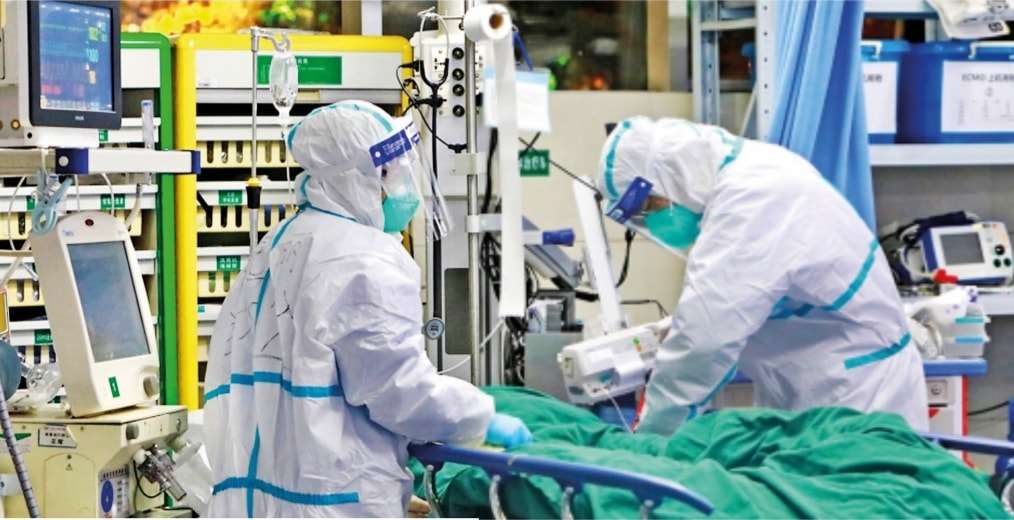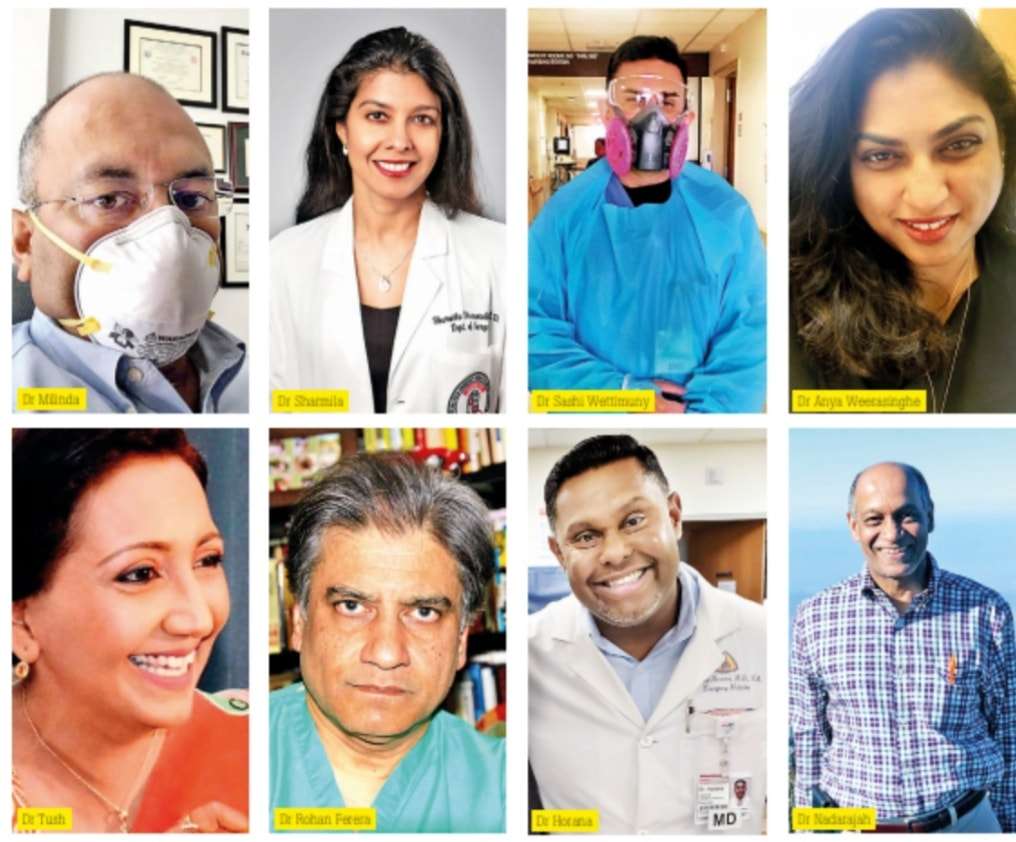
Apr 24 2020.
views 1886The novel Coronavirus pandemic erupted around the world with absolute fury. Countries such as the USA, UK, Italy, and Spain are amongst the worst affected. Many hospitals were caught on the back foot with little or no preparation on how to deal with this mysterious virus. Hospitals saw usual admissions decline as patient after patient with Coronavirus symptoms were admitted and while each hospital became vast COVID-19 units, in some countries like the UK, convention centers were transformed in record time to massive hospitals to deal with the growing influx of COVID-19 patients.

Amongst the thousands of medical personnel ranging from doctors and nurses dealing with the chaos in the wake of this pandemic, there are many Sri Lankans across the world working on the frontline valiantly battling to save the lives of those infected with Coronavirus. In the USA, New York has been hit particularly hard with the death rate in its thousands and infected figures rising rapidly. Local businesses have closed leaving deserted streets and all focus is on the hospitals. When the tests became sporadically available, people watched as their colleagues in ones and twos tested “positive” for the novel Coronavirus. Realisation dawned then that going forward
the world would have a new BC and AC (Before and After COVID-19) to define history.

Speaking to Dr. Aruna Milinda Seneviratne an Associate Professor of Orthopedic Surgery at the Mount Sinai Health System in Manhattan Metro he explained that New York comprises a population of 21,045,000 with 225,234 confirmed COVID-19 cases to date with 17,815 deaths.
Dr. Aruna Milinda Seneviratne is one of the many diasporic Sri Lankan physicians working in the frontlines of the pandemic in the New York Tri-State area. Of his own experience, Dr. Aruna says “There were several opportunities to volunteer and I chose to join the hospitalist team to provide coverage to admit patients at night. A pandemic does not happen only during daylight hours - it’s a 24/7 event, and I thought my services would be best utilized at night. I work 12-hour shifts - 8 pm to 8 am, Thursday to Sunday. Monday to Wednesday I run my orthopedic practice via telehealth
technology.” With regard to the initial fear of coming face to face with COVID-19 positive patients, he continued “you quickly realize that if you use your PPE correctly the risk can be minimized and I don’t even think about it anymore”. On how he deals with stress he said. “I am not sure if I will ever have 6 weeks to enjoy time with my family like I have been able to in the last few weeks. I am thankful to be able to spend quality time with them as the workload is much less than my usual practice of seeing patients and performing surgery. Apart from that, I unwind by training on my road bike”.
Dr. Daya Nadarajah is a Critical Care specialist at Newton Memorial Hospital and Hackettstown Medical Center. He works long days from 7 am until 10 pm sometimes. Asked about dealing with death and stress he said, “I do not think of patients as COVID-19 positive or not – treating critically ill patients is par for the course for me. I simply think that I have a lot more patients to take care of at the hospital. I try to rationalize the reason why patients are dying – I am seeing that most of them are older and have underlying health issues such as obesity”. To take his mind off work Dr. Nadarajah unwinds by walking his dog, relaxing by the lake at his home, or baking on weekends!
Dr. Lasantha Horana, Chairman and Medical Director of Emergency Services, Robert Wood Johnson Teaching Hospital, NJ. supplied a frontline perspective. Asked about concerns he said, “I am most concerned about the health of my co-workers, and the families we go back home to. I am also concerned about if we have enough resources whether it is personal protective equipment, nurses, critical care ventilators and beds, and appropriate medications”. On the subject of mortality, he said that this virus is humbling us all at how quickly it can kill. “We try our best and in the end hope that we made the right choices and treatments to give our patient the best chance possible”.
Dr. Anya Weerasinghe a hospitalist in Manhattan, reports that “I find that we are back to practicing medicine in its purest form, and the most powerful treatment we have is the power of the human touch, kindness, compassion, and dignity. It is a privilege to be able to serve humanity in its darkest hour.” She stated that “it has been heartbreaking to watch patients die without their loved ones around them. It has been hard having to break the bad news to families over the phone several times in one day”. Her most daunting experience has been “seeing my trainees and fellow attending physicians get sick themselves after treating patients.”
Dr. Rohan Perera, Clinical Asst. Professor, Cardiology, University Teaching Hospital Stony Brook, NY, is keen to recognize the quiet heroes in this, the ancillary staff from nurses down to janitorial workers. He describes an example last week when he heard the usually somber PA system crackle to life with the bass line of the Police hit “Every Breath You Take”, and the ward took on a joyful air. A nearby nurse explained, “they play this whenever they get a COVID-19 patient off the ventilator doc, it shows we are winning”. “In Manhattan, since last week, every evening at 7 pm as the sun sets, people take to their windows, rooftops, balconies, and the empty streets ring with applause and the sound of banging pots and pans. This is a version of the 17th-century Cacerolazo usually used for protests but now a resounding cacophonic “thank you” to the healthcare workers of New York as they change shifts. We will survive!” he says.
Over in Lubbox, Texas, Dr. Sharmila Dissanaike a Trauma Critical Care Surgeon and Chair of Surgery is thankful that in Lubbock the daily influx of patients seems to be easing after several weeks of steady increase. Dr. Sharmila is particularly daunted by the experience of patients not being able to have friends and family with them in the hospital. She says “The worst was when one of the patients who died of COVID-19 on a ventilator; his family were present on Facetime but it was very sad for all concerned that they couldn’t be physically in the room with him”
Working as a nurse in California, USA Samanthika worries about the uncertainty of the situation. “I am scared for myself, infecting family and others in contact with me. As a former hospice nurse, I have not been scared of death but the fact that my actions can impact others' lives is overwhelming. Safety and presence of mind is the key to survival.
Describing her routine Samanthika explains “As we enter the hospital our temperature is checked and masks are given. We wash/ scrub our hands for 20 seconds. Then get shift reports at the nurses' station while staying six feet apart. Collect PPE or whatever is left. We are short of supplies at times. At least having an N95 mask and face shield or goggles and a gown is helpful in being safe. Before leaving the hospital we scrub and wipe down shoes, badges, and other belongings with bleach wipes. As I enter the garage at home strip down and take a shower before entering the house.”
Despite the grim news of increasing casualties, Samanthika tries not to focus on the daily statistics, instead, she says “I think of how I can help my patient that day from not becoming a statistic.” Offering more than a word of encouragement to her patients she adds “ as a COVID patient in isolation, we are their only contact. Emotional support is very important. When I perform tasks actually talk with my patients and tell them that they have to fight. I encourage them to perform breathing exercises, move, turn, and ambulate in the room. Moving is key, even though the body wants to lay down. Pulmonary exercises are important. We try to prevent patients from
going to ICU and getting on ventilators when this happens chances of survival is slim.”
Watching Sri Lankan TV shows online and chatting to her husband who she refers to as her absolute rock has helped Samanthika get through these turbulent times. I ask her what her most daunting experience has been to date. She replies “I had to transport a COVID patient in respiratory distress with another nurse by our selves to ICU early morning. I was worried that he will pass away during transport. We were short-staffed. I did not want to call a code in the elevator to intubate. I will never forget his face. He looked at me and asked if he will make it. I did not want to lie and could not answer him. He passed away several days after in ICU.”
For Samanthika the lack of sufficient Personal Protective Equipment is a great concern. “At least we still have N95 masks that we have to use 5 times per patient and eye goggles that we reuse for the same patient. This can cause cross-contamination if we are not careful. Also last week we had no surgical caps and covers. I had to improvise and use surgical underwear on my head as surgical caps and slip-resistant socks given to patients as shoe covers. It worked. This is better than most other hospitals in the country where nurses and doctors have no PPE and are asked to wear surgical masks instead of N95 masks to care for patients. As a result, many health care workers are infected and some are dying.”
Over in the UK, Dr. Tush Wickramanayake who works in an NHS hospital also worries about the lack of PPE. But for her, the biggest concern is “the fear and crippling uncertainty of all governments around the world which are causing indecisive disaster management processes". Back in New York, Dr. Sashi Wettimuny works 12-hour shifts as an Intensivist while his wife Malgorzata works as a nurse. They are both on the frontline and have shared experiences of seeing death on a daily basis. Describing how he deals with the scenes of death that surrounds him he says “you have to care but you have to guard your own heart or it will break from the constant weight of people dying around you. This does not always work and some days the weight breaks through this barrier and you feel awful. But most days you just keep going, to take care of the next patient.
0 Comments